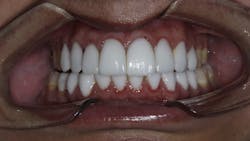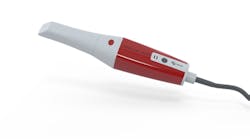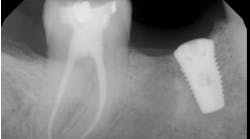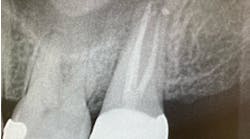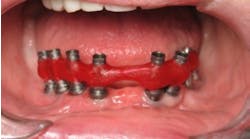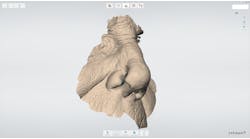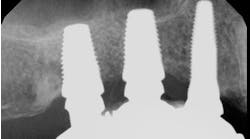Aluminum named allergen of the year and dental restorations can contain aluminum: Explaining this to your patient
The American Contact Dermatitis Society (ACDS) has recently selected aluminum as the Allergen of the Year for 2022. Aluminum salts, which are the major cause of allergic reactions, are “ubiquitous,” said Donald Belsito, MD, a professor of dermatology at Columbia University in New York City during his presentation at the annual ACDS meeting. According to a recent article in Medscape, these salts can be found in sunscreen, cosmetics, food, and dental restorations, though the most common reactions are from aluminum hydroxide, which can be found in some vaccines or preparations for allergen-specific immunotherapy.1
There have also been occasional reports of atopic dermatitis from aluminum in antiperspirants, astringents, as well as from the metallic aluminum. “It’s the aluminum hydroxide that seems to be more allergenic than other aluminum salts,” Belsito told Medscape Medical News.
Additional reading: Why do we get dental crowns that don’t fit?
Aluminum allergies are not thought to be very common, but the overall prevalence is not known. Studies do suggest, however, that the allergy may be more prevalent in children. In a recent study in Sweden, 5% of children and 0.9% of adults who underwent patch testing had an aluminum contact allergy.2
Where is aluminum found in dentistry?
Certain dental implants are made of titanium alloy, which have a component of aluminum in the implant screw. Typically, the alloy is TI6AL4V. Aluminum oxide particles are commonly used as a sandblasting media including divesting the casting investment materials and increasing effective surface area to enhance the mechanical retention strengths of fired porcelain or luting cements.3
According to Steve Pigliacell, MDT, CDT, and owner of Marotta Dental Lab, “Technicians should be careful and warned when working with this material.”
Aluminum oxide can also be used by air polishing units and air abrasion units that remove caries or stain from teeth. Finally, aluminum oxide (alumina) has been used for the purpose of increasing the strength of dental porcelains. Aluminous oxide crowns, unlike zirconia, are more porous and can therefore be acid-etched before cementation, which creates a chemical bond between the crown and tooth making the adhesion very strong. They are also the most esthetic type of porcelain crowns available as they have excellent translucent light-reflective properties, which results in the closest match to natural teeth. Common names include Procera, Empress, and e.max.
Are dental restorations that contain alumina dangerous?
Not all forms of aluminum are readily reactive or have toxicity concerns. To be considered toxic, aluminum must be ionizable or dissociated and be able to chemically bind with tissue. Aluminum oxide is a biocompatible ceramic that has been used as a dental restorative material for many years. It is an inert compound of aluminum and oxygen created by oxidation to form Al2O3, a nonmetal or pure ceramic. Aluminum oxide is the most stable form of aluminum known, and it is not soluble in water.4
In the manufacture of dental ceramics, care is taken to ensure that all the aluminum is converted to the inert alumina compound. Since this ceramic is not water-soluble, there is no way for raw aluminum to leave the crown and enter the blood or the brain. In addition, there are no bodily functions that react with the alumina, and because it doesn’t interact with tissue, toxicity is not an issue. Further, the outside surface of aluminum oxide crowns is covered with a thick layer of dental porcelain; the inside is sealed to the tooth with dental cement. In this way, the aluminum oxide is hidden from saliva and gingival fluids. Dental work containing aluminum oxide doesn’t diffuse aluminum into the bloodstream or saliva.
Conclusion
Aluminum oxide has been used as a dental porcelain pigment for some 75 years and as a ceramic restoration substructure for 40 years. It has a variety of orthopedic uses in hip and knee joints, where it has demonstrated excellent biocompatibility for many years. Dental patients should be reassured that dental ceramics composed of aluminum oxide are not a source of soluble metallic aluminum in the body.
Editor’s note: This article originally appeared in Perio-Implant Advisory, a chairside resource for dentists and hygienists that focuses on periodontal- and implant-related issues. Read more articles and subscribe to the newsletter.
References
- Hicks L. Aluminum named allergen of the year. Medscape. March 25, 2022. https://www.medscape.com/viewarticle/970976
- Siemund I, Dahlin J, Hindsén M, et al. Contact allergy to two aluminum salts in consecutively patch-tested dermatitis patients. Dermatitis. 2022;33(1):31-35. doi:10.1097/DER.0000000000000787
- Oshida Y, Munoz CA, Winkler MM, Hashem A, Itoh M. Fractal dimension analysis of aluminum oxide particle for sandblasting dental Biomed Mater Eng. 1993;3(3):117-126.
- Physical constants of inorganic compounds. In: Lide DR, ed. CRC Handbook of Chemistry and Physics. CRC Press, 1994.
Scott Froum, DDS, a graduate of the State University of New York, Stony Brook School of Dental Medicine, is a periodontist in private practice at 1110 2nd Avenue, Suite 305, New York City, New York. He is the editorial director of Perio-Implant Advisory and serves on the editorial advisory board of Dental Economics. Dr. Froum, a diplomate of the American Board of Periodontology, is a volunteer professor in the postgraduate periodontal program at SUNY Stony Brook School of Dental Medicine. Contact him through his website at drscottfroum.com or (212) 751-8530.
